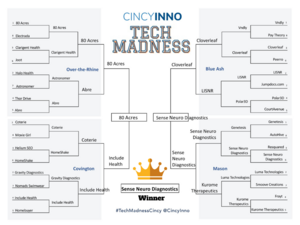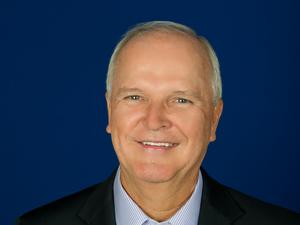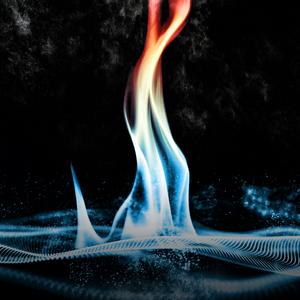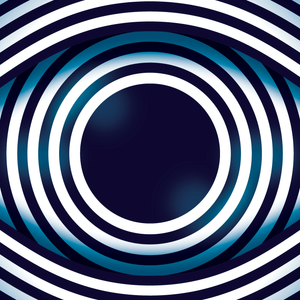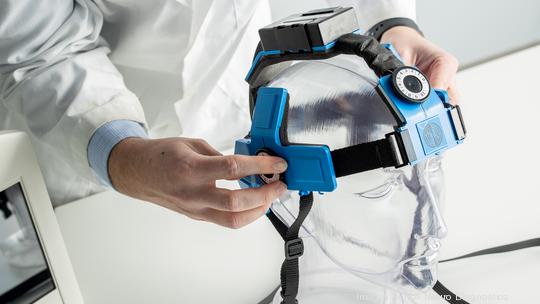
Since its founding in 2014, the team at Sense Neuro Diagnostics has been heads down hard at work. So please excuse the medical device company for not exactly being a household name.
At least not yet. Today, Sense, which calls Norwood-based HCDC home, is making moves at a seemingly accelerated speed after having spent years on R&D. To list just a few of those latest accolades: It added Jack Kraeutler, former CEO of Meridian Bioscience (NASDAQ: VIVO) and a member of Ohio Third Frontier, to its board. StartUs Insights, an Austrian data science company, named Sense to its global top five list of emerging neurological device startups, the only North American company chosen. And, following strong results from initial pilot studies, clinical trials are now underway on one of two Sense devices, a key step toward commercialization.
The company was also the top vote-getter in Tech Madness, Cincy Inno’s friendly bracket-style competition, pulling off four consecutive upsets last month.
Geoff Klass, the company’s CEO since 2019, sat down for an exclusive interview in March to talk more about the company’s mission, and what’s next. The following has been edited for space and brevity.
Meet Sense Neuro Diagnostics
- Company leadership: Geoff Klass, CEO; Daniel Kincaid, COO; Dr. Opeolu Adeoye, CMO; Dr. George Shaw, CTO; Dr. Matt Flaherty, CCO; Paul Gaitan, CFO; Joseph Korfhagen, VP product development
- What it is: A medical device startup founded by four University of Cincinnati physicians to improve outcomes for stroke and brain injury patients.
- Funding: $7 million seed, including $1.5M in grants from National Science Foundation.
- Investors: Queen City Angels, Accelerant Ventures Dayton, Cleveland Clinic, Global Cardiovascular Innovation Fund, private group of Cincinnati-based neuro physicians
- Its tech: Two devices, both non-invasive brain scanners being developed to assess and monitor a patient's neurological status in real time. One, a smaller headset for field assessment, like in an ambulance, and another for continuous monitoring in a hospital’s neuro-ICU. The headsets include antennae that transmit a low-power radio frequency through a patient's head – healthy brain tissue, for example, has unique electrical properties – that can detect expanded brain hemorrhage and differentiate between three different stroke subtypes
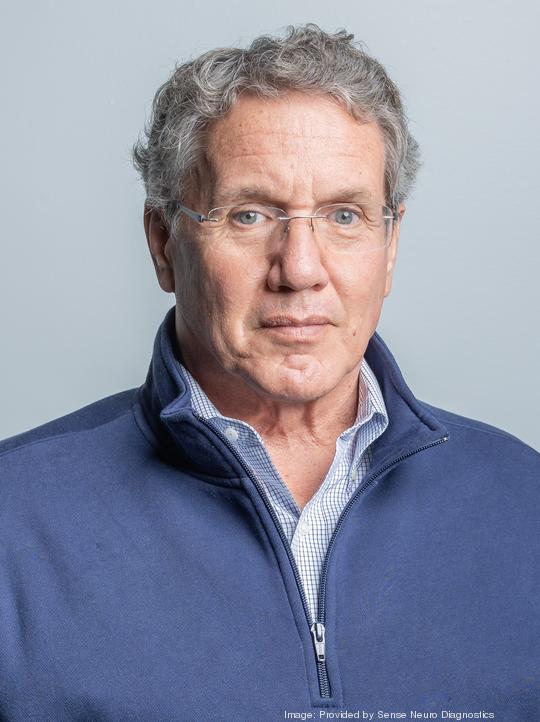
Talk about the company’s origin? Where did this idea come from, and, overall, how did the technology for Sense Neuro Diagnostics develop?
It’s an old story setting – sitting at a bar at LAX (Los Angeles International Airport), four of the company’s founders were coming back from a stroke conference, and it was about trying to identify a problem. For people suffering from stroke or traumatic brain injury, there really is no objective way to triage when patients are in the field or to monitor their condition on an ongoing basis while they’re in the hospital. Dr. [George] Shaw used to work at the Naval Research Laboratory, and he basically said, ‘What if I take radar and turn it inside to scan the brain?’ That was really the genesis of the development of this technology and this company.
Describe how these devices work in real time?
The standard of care today, if you’re potentially suffering a stroke or if you were in a car accident and hit your head, when the EMTs show up at the scene, they do a very subjective check called the GCS scale. They’ll look in your eyes, speak to you, have you move your extremities, and they assign a score, and from that score they determine the proper course of care. But there’s no way of knowing which of the three types of strokes that you’re having. Our devices are designed to tell an EMT exactly what’s going on inside the brain. And in an ambulance, time matters. Time is brain. Depending on what type of stroke they’re having determines the course of care they should most effectively be taking. This way, you get the right people at the right hospital, and you know what you’re bringing them in there for.
In the hospital, patients in a neuro ICU who are susceptible to an expanded brain bleed, they currently receive the exact same continuum of care that happens out in the field. Every hour, a nurse or a doctor will perform that same GCS scale. Often times, however, the outward signs of an expanded bleed are not readily present in that exam. Our device would pick it up immediately.
Who are your target customers?
Initially ambulances and hospitals. From there, we’ll expand out to all those points in the field where a stroke or traumatic brain injury could present itself – so emergency care facilities, military, private physician offices, schools, there’s an application in sports, which is very important. Our market expands greatly when you look at where we could apply this device.
This technology is also not limited to stroke and traumatic brain injury. This year, we’re funding a lot of the base R&D in order to begin look at other applications, like oncology for the possible early detection of brain cancer.
Talk about the company’s clinical trial efforts, and where those studies will be taking place.
Right now, we’re in our pivotal trial, which is the study that will take us to FDA submission for approval to become a commercial product. We’ll probably have a total of 15 sites in the U.S. and Canada and four initial sites in India. For the U.S. sites, we’re trying to pick them strategically so we can be located around the country. They will also become hub for our commercial launch of the product. UC (University of Cincinnati) will be one. We hope to get the trial completed by the end of the year, and with a bit of luck, we hope to be approved for commercial use by mid-2022.
The reason for the sites in Canada and India, the Canadian government is very interested in what we have, and in India, stroke is the second leading cause of death. Half a million people a year die of traumatic brain injury in that country, and there’s an extreme effort to drive down those numbers. We’re coming in at a very opportune time.
As you start to eye commercialization, who are your competitors? What makes Sense unique?
The fact that we can differentiate between all three stroke subtypes makes us stronger than our competition. There is one company that can also differentiate between the stroke subtypes, but their device is rather large. You’re not going to convince an ambulance company to give up space to put a large device into the vehicle.
We feel very comfortable with our position. When it comes to in-hospital monitoring, we’re the only company developing a product to handle that.
What’s next for the company?
With any startup, you’re always in funding mode. We’re really not at liberty to talk about that part right now. But this is such an exciting company – the applications for this are in such great need. You need no motivation to come in and work everyday to try and make this happen.
